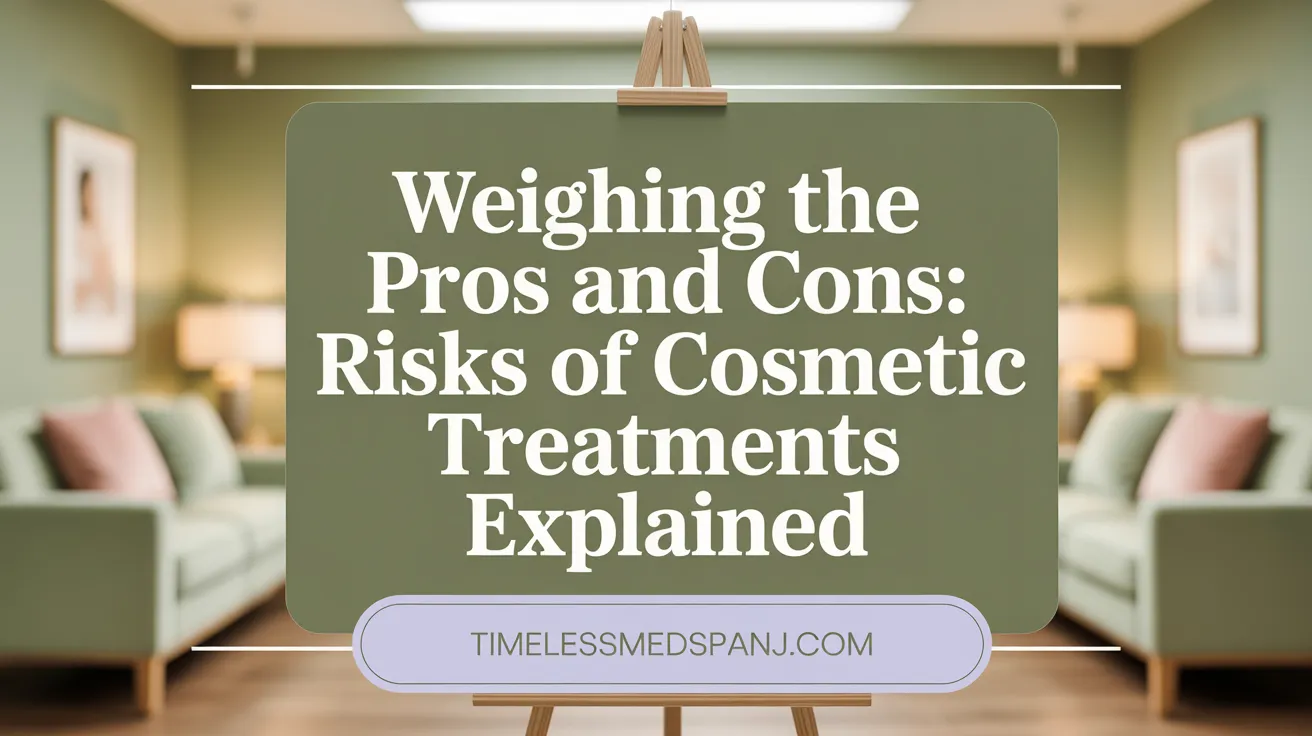Introduction to Botox and Dermal Fillers
Botox and dermal fillers are among the most popular cosmetic procedures used to reduce wrinkles, restore volume, and enhance facial features. While generally safe when performed by qualified medical professionals, these treatments carry potential side effects and risks that patients must understand. This article explores the common and rare adverse effects, safety precautions, long-term considerations, and management strategies to help you make informed decisions about Botox and fillers.
Key Considerations Before Receiving Botox and Fillers

What do I need to know before getting Botox and fillers?
Before proceeding with Botox or dermal fillers, it’s essential to do thorough research and consult with a qualified healthcare professional. A licensed practitioner can assess your facial structure and medical history to determine the most suitable treatment plan.
Choosing products that are FDA-approved helps ensure safety and effectiveness. Many dermal fillers like hyaluronic acid-based Juvederm and Restylane, as well as Botox, are regulated, reducing the risk of adverse reactions.
Understanding how long the effects last is important. Botox typically offers results that last about 3 to 4 months, while fillers can last from 6 months to several years depending on the type. Repeated treatments are often needed to maintain the desired appearance.
Side effects are usually mild but may include bruising, swelling, or temporary muscle weakness, and in rare cases, eyelid drooping. Discuss any medical conditions, allergies, or medications with your provider. Certain health issues may contraindicate treatment or increase risks.
Setting realistic goals is crucial. These cosmetic treatments improve appearance subtly rather than eradicating wrinkles completely. Clear communication with your provider about your expectations can help achieve natural-looking results.
To minimize risks, always opt for experienced, licensed professionals, and disclose your full medical history beforehand. Following post-treatment instructions, such as avoiding rubbing the area or strenuous activity, can also help ensure safe and optimal outcomes.
Common and Serious Side Effects of Botox

What are the potential side effects of Botox?
Botox is generally considered safe when administered by a qualified healthcare professional. Most common side effects include mild reactions at the injection site such as pain, swelling, redness, or bruising. These typically resolve within a few days. Patients might also experience headaches, flu-like symptoms, or temporary muscle effects, like droopy eyelids (ptosis) or asymmetry in facial expressions.
While most side effects are mild and short-lived, there are rare but serious complications to be aware of. These include the spread of botulinum toxin beyond the intended area, which can cause muscle weakness, vision problems, difficulty swallowing, or breathing issues — symptoms that require immediate medical attention.
The occurrence of complications is often linked to higher doses or improper injection techniques, making the importance of choosing a trained and experienced provider crucial. Most side effects resolve within days to a few weeks, but persistent or severe symptoms must be reported promptly to a healthcare provider.
Injection site reactions
Many patients notice swelling, bruising, redness, or tenderness at the injection site. These reactions are common, temporary, and manageable.
Temporary muscle effects
Botox works by blocking nerve signals, leading to muscle relaxation. Notably, some individuals may experience eyelid drooping, asymmetry, or muscle weakness outside the targeted areas.
Headaches and flu-like symptoms
These symptoms can occur shortly after treatment and usually subside within a few days. Staying hydrated and using over-the-counter pain relievers can alleviate discomfort.
Droopy eyelids and asymmetry
One of the well-known side effects of Botox involves eyelid ptosis, which can occur in up to 20% of cases if the toxin affects the eyelid muscles. Temporary facial asymmetry or brow drooping can also happen but typically improves over time.
Rare serious complications
More serious risks include potential spread of toxin resulting in muscle weakness or paralysis, vision changes, or difficulty swallowing and breathing. Such effects are extremely rare but necessitate urgent medical care. Risks increase if injections are administered improperly or at high doses.
Importance of professional administration
To minimize risks, it is essential to have Botox administered only by a licensed and experienced healthcare provider. Proper assessment, technique, and dosage are vital in reducing adverse effects. Patients should disclose their full medical history, including allergies and medications, before treatment. Following post-treatment guidelines, such as avoiding rubbing the area or strenuous activity immediately afterward, also helps prevent complications.
By understanding these potential side effects and choosing qualified practitioners, patients can enjoy the aesthetic and medical benefits of Botox while maintaining safety.
Potential Side Effects and Risks of Dermal Fillers

What are the potential side effects of dermal fillers?
Dermal fillers, popular for restoring facial volume and smoothing wrinkles, generally have a high safety profile when administered properly. Most common mild reactions include temporary pain, swelling, redness, soreness, and bruising at the injection sites. These usually resolve within a few days to two weeks.
In some cases, individuals may experience itching, palpable lumps or bumps, and skin discoloration, such as the Tyndall effect, which causes a bluish tint under the skin. Mild numbness or tenderness can also occur temporarily.
What are rare but serious risks?
Although rare, serious risks include infection, forming of nodules or granulomas, allergic reactions, or undesirable tissue reactions. The most dangerous complication is vascular occlusion, where the filler inadvertently enters or compresses a blood vessel, blocking blood flow. This can lead to tissue necrosis (death), skin discoloration, or even blindness if injection occurs near the eyes.
How does vascular occlusion and tissue necrosis happen?
Vascular occlusion is a consequence of improper injection technique or inaccurate site selection. When blood flow is blocked, tissues downstream can die due to lack of oxygen. Emergency measures, including administering hyaluronidase (a dissolving enzyme) for hyaluronic acid fillers, can sometimes restore blood flow before permanent damage occurs.
Are allergic reactions common?
Allergic responses are uncommon but possible, especially in patients with sensitivities to components of the filler or preservatives. Symptoms may include swelling, redness, hives, or more severe reactions like anaphylaxis. A thorough medical history and allergy testing can help reduce this risk.
What about migration and asymmetry?
Fillers can migrate from the original injection site, leading to asymmetry or lumps, especially if injected into areas with high mobility or if not injected properly. Migration can also occur over time due to tissue movement or improper product selection.
Importance of choosing qualified practitioners
To minimize these risks, it is essential to seek treatment from licensed, experienced medical professionals. Proper training, sterile technique, and knowledge of facial anatomy significantly reduce the chances of adverse effects. Patients should disclose their full medical history and allergies, and follow all pre- and post-treatment care instructions.
| Risk Type | Description | Prevention Tips |
|---|---|---|
| Common mild reactions | Bruising, swelling, redness, tenderness | Use proper injection techniques, cold packs post-treatment |
| Rare serious risks | Infection, botulism-like effects, nodules, granulomas | Choose qualified practitioners, sterile procedures |
| Vascular occlusion & tissue necrosis | Blockage of blood flow, tissue death | Careful site selection, prompt recognition, use of hyaluronidase |
| Allergic reactions | Swelling, hives, anaphylaxis | Allergy screening, testing before treatment |
| Migration and asymmetry | Uneven placement, lumps, unwanted movement of filler | Experienced injector, appropriate filler choice |
Being informed about these potential side effects and choosing skilled professionals can greatly enhance safety and achieve the desired aesthetic or medical outcomes.
Overall Risks and Downsides of Botox and Fillers
 Both Botox and dermal fillers are widely used cosmetic treatments that can effectively reduce the appearance of wrinkles and restore facial volume. However, like all medical procedures, they carry certain risks and potential downsides.
Both Botox and dermal fillers are widely used cosmetic treatments that can effectively reduce the appearance of wrinkles and restore facial volume. However, like all medical procedures, they carry certain risks and potential downsides.
Mild side effects are common and usually temporary. These include pain, swelling, bruising, or redness at the injection sites, often resolving within a few days. Some individuals may experience headaches, flu-like symptoms, or minor skin irritation. For Botox, specific concerns include droopy eyelids (ptosis), asymmetry, dryness or watery eyes, and occasional allergic reactions. Fillers may cause lumps, unevenness, or mild allergic responses.
Serious but rare complications can involve muscle weakness, difficulty swallowing or breathing, vision issues, or tissue necrosis if the product inadvertently affects blood vessels. These adverse effects are more likely when injections are performed improperly or by inexperienced practitioners.
The skill and experience of the injector play a crucial role in minimizing risks. An experienced healthcare professional can ensure proper technique, correct dosing, and appropriate placement, reducing the chance of complications.
Patient education is essential. Patients should disclose their full medical history, including allergies, medications, or underlying conditions like neuromuscular diseases. Following pre- and post-treatment instructions can greatly decrease the likelihood of adverse effects.
In summary, while Botox and fillers are generally considered safe when administered by qualified practitioners, awareness of possible side effects and choosing skilled providers are vital steps to ensure safe and satisfactory outcomes.
Safety Precautions and Post-Treatment Care
What precautions should be taken after receiving Botox and fillers?
After receiving Botox or dermal fillers, certain steps can help ensure the best results and minimize side effects. It is recommended to avoid alcohol and tobacco for at least 24 hours post-treatment. These substances can increase the likelihood of bruising and slow down the healing process.
Additionally, staying away from extreme heat sources such as saunas, hot tubs, or intense sunlight for about 48 hours is essential. Excessive heat can promote swelling or cause the filler or toxin to migrate from the injection site.
Patients should follow their healthcare provider’s instructions carefully, which may include avoiding strenuous activity and not massaging or rubbing the treated area. Disclosing your full medical history and current medications helps your practitioner guide you safely through the recovery process.
Choosing qualified practitioners is crucial to reduce risks. Licensed healthcare professionals trained in administering these treatments follow proper techniques and guidelines to minimize adverse effects.
By adhering to these precautions and post-care steps, patients can enjoy safer treatments and optimal results.
Botox and Organ Health: Myths and Facts
Is Botox harmful to the liver or kidneys?
Botox is generally considered safe when administered by qualified healthcare providers. It is not broken down by the liver or kidneys, as it primarily works through localized injections into facial muscles. This means that it has minimal systemic presence, reducing concerns about toxicity or damage to these vital organs.
The mechanism of Botox involves blocking nerve signals in the targeted muscles, leading to temporary muscle relaxation. This process does not involve metabolism in the liver or kidneys, so there’s little risk of these organs being harmed.
Most side effects involve local reactions such as redness, swelling, or eyelid drooping, which are tied to injection technique rather than organ health.
In summary, there is no scientific evidence to suggest that Botox damages the liver or kidneys when used properly. When administered correctly, Botox is a safe procedure with no direct impact on these organs.
Addressing Concerns About Botox and Cancer Risk
Does Botox cause cancer?
There is currently no scientific evidence directly linking Botox to cancer. Most side effects associated with Botox are mild and temporary, such as pain, swelling, and headaches. Serious adverse reactions are rare and are often related to counterfeit products or improper administration.
While long-term use of Botox can lead to permanent changes in facial muscles, these are unrelated to cancer development. Some fears include the potential toxicity of botulinum toxin or its spread beyond the targeted muscles, but the doses used in cosmetic procedures are very low and generally safe.
Regarding central nervous system risks, although a theoretical concern exists that toxins might enter the brain, studies show that treatment doses are insufficient to cause such effects. When performed by licensed, qualified practitioners, Botox has a proven safety record.
In summary, based on available research and clinical experience, Botox does not cause or increase the risk of cancer. Most side effects remain mild and temporary, and serious complications are exceedingly rare.
Long-Term Effects and Neurological Risks of Botox
Are there any long-term side effects associated with Botox?
Long-term use of Botox is generally safe when administered correctly by qualified healthcare professionals. However, repeated treatments can lead to cumulative effects on the muscles injected. Some individuals may experience muscle weakening or atrophy, which means the muscles become smaller and weaker over time.
This muscle change can sometimes cause permanent alterations in facial appearance, such as a mask-like expression or less movement in targeted areas. While many users benefit from reduced wrinkles and prolonged effectiveness, these muscular alterations might diminish the natural expressiveness of the face.
There is also evidence suggesting that long-term Botox use could influence muscle behavior, resulting in less expressive features as muscles become less active. Some studies propose this might contribute to a more youthful appearance but can potentially impact emotional recognition, as facial muscles play a role in emotional processing.
Another concern is the formation of antibodies against the toxin. When the immune system develops antibodies, it can reduce Botox's effectiveness, necessitating higher doses or alternative treatments. Though rare, this immunoresistance can limit long-term benefits.
Additionally, some reports hint at potential subtle impacts on brain activity and emotional recognition, although more research is needed to understand these effects fully. Serious adverse effects related to long-term use are exceedingly rare but underscore the importance of undergoing treatments under professional supervision to minimize risks.
Ensuring procedures are performed by licensed practitioners and following their guidance for frequency and dosage can help mitigate these long-term risks.
Can Dermal Fillers Negatively Impact Facial Appearance?

Will dermal fillers ruin your facial look?
When administered correctly by licensed healthcare providers, dermal fillers are a safe and effective way to improve facial appearance. They are designed to restore volume, smooth wrinkles, and enhance features such as lips, cheeks, and jawlines. However, if not applied properly, they can cause unsatisfactory results.
Improper technique or overuse may lead to an unnatural, "pillow face" appearance, with lumps or uneven contours that diminish natural facial expressions. Inexperienced injectors might also inject in the wrong areas, leading to asymmetry or visible irregularities.
What are the risks of poor injection technique?
Incorrect injection can cause serious issues like blood vessel blockage, which can lead to tissue death and permanent disfigurement. Using unapproved substances like industrial silicone or attempting to inject without proper tools can result in severe, long-lasting injuries. Vascular complications, though rare, are among the most serious risks associated with these procedures.
How does overuse affect facial aesthetics?
Using too much filler can create an overly plump or unnatural look, often referred to as "overfilled" or "pillow" face. It can also cause skin stretching, leading to a loss of natural facial expressions over time. Repeated treatments without proper assessment may eventually diminish facial harmony.
Why are incorrect injections dangerous?
Mistakes during administration—such as injecting into blood vessels or too deeply—can cause skin necrosis, blindness, or stroke. These complications underscore the importance of treatments performed by skilled, licensed professionals who follow best practices.
Why is patient education and choosing the right practitioner crucial?
Patients should thoroughly research and select qualified, experienced specialists for their fillers. Proper consultation includes understanding the product used, potential risks, and aftercare requirements. Following post-treatment instructions and disclosing complete medical histories help mitigate adverse effects.
| Aspect | Potential Impact | Prevention Tips |
|---|---|---|
| Natural appearance | Unnatural contours, "pillow face" | Use experienced, licensed practitioners |
| Serious health risks | Vascular occlusion, tissue necrosis | Avoid unapproved substances, request proper technique |
| Long-term effects | Migration, permanent disfigurement | Follow aftercare and treatment intervals |
| Reaction risk | Allergic or immune reactions | Disclose allergies and health conditions |
Ensuring treatments are performed by qualified professionals significantly reduces the chances of developing undesirable or dangerous outcomes from dermal fillers.
For more information on the risks and appearance issues associated with dermal fillers, searching "dermal fillers risks and appearance issues" can provide further insights.
Final Thoughts on Botox and Fillers Safety
Botox and dermal fillers offer effective solutions for cosmetic enhancement and certain medical conditions, but they are not without risks. Understanding the common and rare side effects, safety protocols, and the importance of receiving care from qualified professionals is crucial to achieving desired outcomes while minimizing complications. Patients should communicate openly with their providers about health history and medications and carefully follow all post-treatment instructions. While long-term effects and serious adverse events are uncommon, being informed helps ensure safer, more satisfying treatment experiences. Ultimately, knowledgeable decision-making and proper care are the keys to safely enjoying the benefits of Botox and fillers.
References
- The Risks of Botox and Fillers: What You Need to Know - AAFE
- Botox Injections: Treatment, Recovery & Side Effects - Cleveland Clinic
- Botox injections - Mayo Clinic
- Botox vs. fillers: Uses, effects, and differences - MedicalNewsToday
- Botox vs. Dermal Fillers: Uses, Cost, Side Effects, and More - GoodRx
- Botox Side Effects: What You Need to Know Before Your Treatment
- Fillers: Contraindications, Side Effects and Precautions - PMC
- Botox Side Effects and What to Do About Them - Healthline
